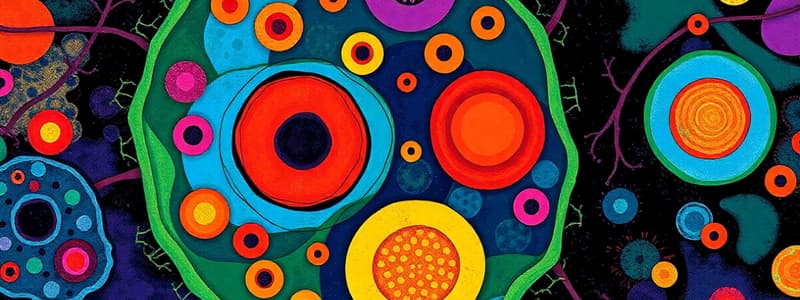Podcast
Questions and Answers
What is the primary function of mitochondria in eukaryotic cells?
What is the primary function of mitochondria in eukaryotic cells?
- Energy storage
- Protein synthesis
- Modifying proteins
- Generating energy through cellular respiration (correct)
Which of the following processes occurs first during cell division?
Which of the following processes occurs first during cell division?
- Meiosis
- DNA replication (correct)
- Translation
- Mitosis
Which component of the cell is involved in intracellular digestion?
Which component of the cell is involved in intracellular digestion?
- Endoplasmic reticulum
- Ribosomes
- Golgi apparatus
- Lysosomes (correct)
What role do ribosomes play in the cell?
What role do ribosomes play in the cell?
What distinguishes eukaryotic cells from prokaryotic cells?
What distinguishes eukaryotic cells from prokaryotic cells?
Flashcards
Cell function
Cell function
Cells are the basic units of life, carrying out all life processes such as growth, reproduction, and metabolism.
Cellular Respiration
Cellular Respiration
The process where cells break down glucose to release energy in the form of ATP.
DNA Replication
DNA Replication
The process of copying DNA to make an identical copy for cell division.
Carbohydrates
Carbohydrates
Signup and view all the flashcards
Ecosystem
Ecosystem
Signup and view all the flashcards
Study Notes
Cell Structure and Function
- Cells are the basic structural and functional units of life. They exhibit a high degree of organization and complexity.
- Cells are surrounded by a cell membrane, a selectively permeable barrier that regulates the passage of substances into and out of the cell.
- Eukaryotic cells contain membrane-bound organelles, including the nucleus, mitochondria, and endoplasmic reticulum, each with specific functions.
- Prokaryotic cells, such as bacteria, lack membrane-bound organelles.
- The nucleus contains the cell's genetic material (DNA) organized into chromosomes.
- Mitochondria are the powerhouses of the cell, responsible for generating energy through cellular respiration.
- The endoplasmic reticulum is involved in protein and lipid synthesis.
- Ribosomes are the sites of protein synthesis.
- The Golgi apparatus modifies, sorts, and packages proteins for secretion.
- Lysosomes are involved in intracellular digestion.
- Vacuoles are involved in storage and transport.
- Cytoskeleton provides structural support and facilitates movement within the cell.
Cellular Processes
- Cellular respiration is the process by which cells break down glucose to release energy in the form of ATP (adenosine triphosphate).
- Photosynthesis is the process by which plants and other organisms convert light energy into chemical energy in the form of glucose.
- DNA replication is the process by which DNA is copied to ensure genetic continuity.
- Transcription is the process by which DNA is used to create a messenger RNA (mRNA) molecule.
- Translation is the process by which mRNA is used to create a protein.
- Cell division includes mitosis (for growth and repair) and meiosis (for sexual reproduction).
- Mitosis involves the division of a single cell into two identical daughter cells.
- Meiosis involves the division of a single cell into four haploid daughter cells.
Biological Molecules
- Carbohydrates are a source of energy and structural components.
- Proteins have diverse functions, including structural support, catalysis (enzymes), and transport.
- Lipids are involved in energy storage, insulation, and membrane structure.
- Nucleic acids, DNA and RNA, are involved in information storage and transmission.
Ecology
- Ecology studies the interactions between organisms and their environment.
- Ecosystems are composed of both biotic (living) and abiotic (non-living) components.
- Populations are groups of individuals of the same species in a given area.
- Communities are groups of different populations interacting in a given area.
- Food webs depict the feeding relationships within an ecosystem.
- Nutrient cycles describe the movement and transformation of elements within an ecosystem.
- Energy flow describes the movement of energy through an ecosystem.
- Human activities can have significant effects on ecosystems, and these can be positive or negative.
Genetics
- Genes are segments of DNA that contain the instructions for producing proteins.
- Alleles are different forms of a gene.
- Dominant alleles express their trait even if a recessive allele is present.
- Recessive alleles express their trait only when two copies are present.
- Genotype refers to the genetic makeup of an organism, while phenotype refers to the observable traits.
- Mendelian genetics describes the basic principles of heredity.
- Non-Mendelian inheritance patterns occur beyond simple dominant and recessive relationships.
- Mutations are changes in DNA sequence, which can be harmful, beneficial, or neutral.
- Genetic variation is essential for evolution.
Evolution
- Evolution is the process by which populations of organisms change over time.
- Natural selection is a mechanism of evolution where organisms with advantageous traits are more likely to survive and reproduce.
- Adaptation is the process by which organisms become better suited to their environment.
- Speciation is the formation of new species from existing ones.
- Phylogenetic trees depict the evolutionary relationships between organisms.
Homeostasis
- Homeostasis is the ability of an organism to maintain a stable internal environment.
- Various mechanisms such as negative feedback loops maintain homeostasis.
- Internal conditions like body temperature, pH, and water balance are regulated to maintain cell function.
Human Biology (Illustrative)
- The human body is composed of various organ systems working together.
- The digestive system breaks down food for absorption and energy.
- The respiratory system facilitates gas exchange.
- The circulatory system transports materials throughout the body.
- The nervous system controls and coordinates body functions.
- The immune system defends against pathogens.
Diversity of Life
- Living organisms are categorized into different domains (Bacteria, Archaea, Eukarya).
- Organisms belong to various kingdoms, such as Animalia, Plantae, Fungi, Protista.
- Species are the basic units of biological classification.
- Organisms are classified based on shared characteristics.
Studying That Suits You
Use AI to generate personalized quizzes and flashcards to suit your learning preferences.




